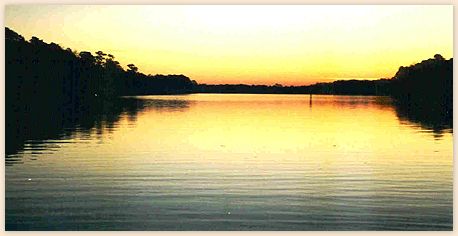A mixture of salt and freshwater settles over
miles of narrow, white sand flats blanketed by
a sea of grass. Nowhere in North America is
there a more diverse estuary than the Neuse River.
Experience the thrill of being an arms length
from heart stopping fly-fishing action. Mother
Nature has crowned this area one of
the most pristine and diverse ecosystems on the
continent, second in size only to Chesapeake Bay.

The seasons dictate the fish species you will catch.
In the late summer when there is no wind, you would
wish for a pocket full of clouds to raise a cooling
breeze. Understand this beautiful place and I'll
take you on a journey to catch some unforgettable
memories. Let's embark now on the first in this
series to explore the estuaries of the Neuse River
System.
The Neuse's waters, river and creeks provide approximately
2,750 acres of prime nursery habitat, and 1,250 acres of
secondary nursery habitats. The upper reaches of the
Neuse provide an important habitat for such fish as
shad, herring, catfish, bass, and flounder. The Neuse
is also home to vital populations of blue crab (estimated
to top those in Chesapeake Bay) and oysters.
Of the 3.5 million acres in the Neuse Basin, 48,000
acres are state parks, 110,000 acres are game lands
held by the Wildlife Resources Commission, and 58,000
acres are National Forest. The Neuse River drains land
in 19 counties covering 6,192 square miles. More than
1,500,000 people (1/6 North Carolina's population) live
in the basin. Many people come to visit each year.
There are million acres of plush marine habitat
including the widest variety of sea grasses from
Johnson's, manatee, paddle, shoal, star, turtle,
eel and widegon grass. These grasses house the
majority of fishes and provide needed oxygen and
forage for their healthy survival.
Whether you fish, paddle, or just enjoy the environment,
take your camera for some breath-taking scenery. From
New Bern to Oriental and Lower Broad Creek and the Mouth
of the Bay River (the entrance to Pamlico Sound) you'll
find many public access points for boating You can hirer
a fishing guide to take you to prime light tackle or
fly fishing, or eco-tours for sightseeing by pontoon
or kayak. There is a lot to do, and don't forget your
sunscreen and polarized glasses.
The Neuse is one of only three rivers in North Carolina
whose boundaries are located entirely within the state.
It begins northwest of Durham, NC, in a 10-acre farm
pond, the headwater of the Eno. From there it feeds
into Falls of the Neuse Lake, located on the north
side of Raleigh, NC. Consequently, the Neuse starts
in the heart of one of the fastest growing areas in
the United States. From the Raleigh-Durham area, where
it is a freshwater river, it flows generally south and
east toward the Pamlico Sound, passing through many
cities, farms, and swamps. It becomes a shallow,
slow-moving, brackish estuary just upstream from
the city of New Bern, in western Craven County. It
is wider here at its upper estuary and is affected
by wind-driven currents, as well as by salt water
"wedges" that move upstream from Pamlico Sound. The
lower Neuse estuary begins in the area of Flanners
Beach and Minnesott Beach and continues until it
empties into Pamlico Sound. There, the mouth of the
Neuse is the widest river mouth in the continental
US. The Neuse River is one of three large rivers
that flow into the Albemarle and Pamlico Sounds.
This estuarine system is the second largest in
the United States.
At an estimated 2 million years, the Neuse is one of
the oldest rivers in the US. Archeological evidence
indicates the first humans settled around the Neuse
as early as 14,000 years ago. Early native American
settlers included the Tuscaroras, Coree, Secotan,
and Neusiok Indians. A struggle between early European
settlers and the Tuscaroras drastically reduced the
European population after the decisive "Tuscaroran War"
in 1714. As new settlers populated North Carolina
during the next 250 years, farming and forestry took
hold. Today, over 1.5 million people live in the
watershed from the sprawling suburbs of the Raleigh-Durham
Triangle area to the golf and sailing communities of
Oriental, the sailing capital of North Carolina.
The nearly 2 million year old Neuse River is a majestic,
flowing lady that has her beginnings above Durham, NC
where the Eno and Flat rivers converge. The Neuse River
is a vital part of the United States second largest
estuary, the Albermarle-Pamlico. The Neuse's current
is fast moving for 150 miles from its source until
she reaches western Craven County and becomes a
slow-moving, brackish estuary that continues for
another 40 miles.
Combine this river system with the confluence, just
offshore of the Outer Banks, the two mighty systems,
the Gulf Stream and the Labrador Current, and you
have the makings for one of the most diverse
estuaries in continental North America. Feeding
the back of the Banks, along Core Sound and down
the Neuse meeting in Pamlico Sound. This is a
virtual nursery for every type of game fish known
including Tarpon, and one other elusive fish that
is Harry's secret.
This series focuses on the fishery, the habitat,
types of flies and techniques used, and the seasons
of fishing in Eastern North Carolina. This fishery
is diverse as it changes from season to season
depending on Mother Nature, wind, salinity and food
sources. You'll experience a pleasurable fly-fishing
adventure like the search for the loot from one of
Black beard's galleons. Our journey starts in
Mid-January as we ready for stripers and shad
on the upper Neuse River in a place called Pitch Kettle.
~ Doug Sinclair
About Doug:
Capt. Doug Sinclair has relocated from New Smyrna Beach, Florida to
Grantsboro, NC. He specializes in fly-fishing and light tackle charters.
Doug charters the Coastal Carolina area of New Bern or Oriental.
Catch him on the web at
www.flyfishacademy.net or call him at (252) 745-3500.
|


